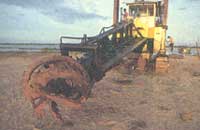Short cut to disaster
Short cut to disaster

EVER SINCE a 3-km straight-cut was dug into the Upputeru channel to speed up draining of water from Kolleru lake into the Bay of Bengal in 1972, soil erosion has plagued the tiny island of Chinna Gollapalem, situated where the lake waters meet the sea. The gushing waters of Upputeru and the sea undercurrents have virtually washed out farming on the island. Today, once-rich farmers have become small-time labourers.
T Chintanna became mentally deranged after his one-hectare coconut grove fell victim to erosion. Another farmer took to being a coolie when his four-ha piece of land on which he had planted casuarinas just disappeared.
The farmers also face a peculiar problem: They have been driven out of the marriage market because mainlanders refuse to accepts their plots of land offered as wedding gifts.
The swirling waters have so far lapped up some 600 ha of casuarina and coconut plantations, affecting about 400 farmers. The cyclones of 1977 and 1990 and the unprecedented August 1986 floods worsened the problem.
The village was earlier linked to the mainland, but turned into an island after the straight-cut was dug, with the sea on one side and the drain on the other. Mounds of earth fall as the waters nibble at the shore. Huge casuarina and coconut trees along the shore stand precariously with their roots exposed.
Hapless farmers were forced to cut the casuarina plantations at several locations along the course to save whatever little they could of the crop. Farmers cultivating groundnut, mango, cashew and other cash crops in the interior were lucky although a Damocles' sword still hangs over their heads.
To mitigate the sufferings of the farmers, the state government under the World Bank-aided Cyclone Emergency Relief Programme (CERP), has undertaken a Rs 14-crore project to dig open the blocked mouth of the sea and desilt the Upputeru drain course to prevent further erosion of the island. Four dredgers and 20 tractors have been pressed into service for desilting operations. Another 20 tractors will be deployed soon and these operations would cost Rs 5.2 crore.
A youth who championed the cause of the farmers said the victims had represented to the district authorities and higher-ups at least a dozen times, seeking compensation in cash or kind, but to no avail. Loss of 0.4 hectare crop of casuarina alone accounted to Rs 20,000, leave alone the cost of the fertile lands. The total loss ran into several crores of rupees, he said.
It was more tragic for T Anjaneyulu, another farmer. His daughter rushed to the village, reportedly on instructions of her in-laws, to take away whatever little money remained with him after he lost his small piece of land with casuarina trees. He died of shock. Chinna Gollapalem island resounds with heart-rending stories of such farmers.







